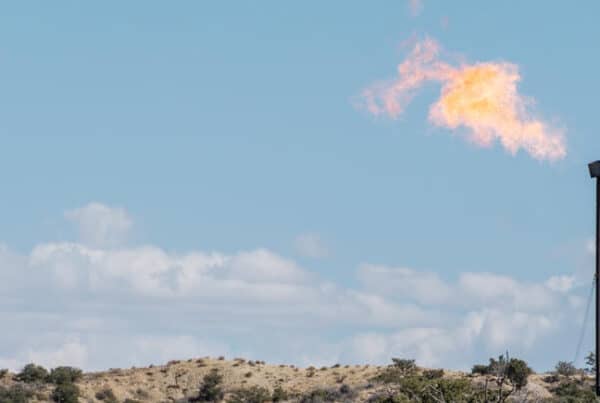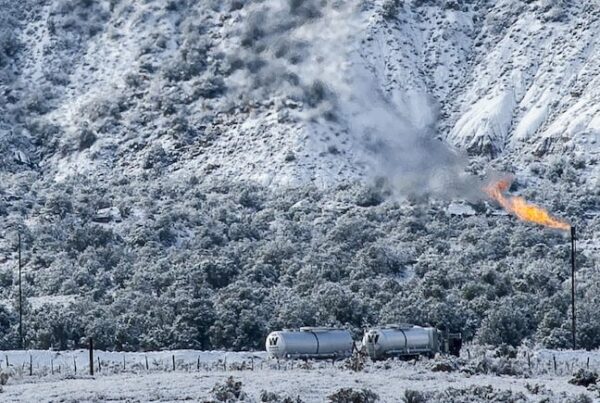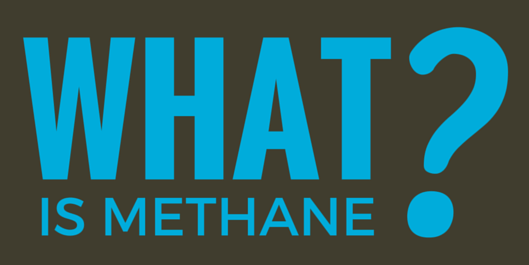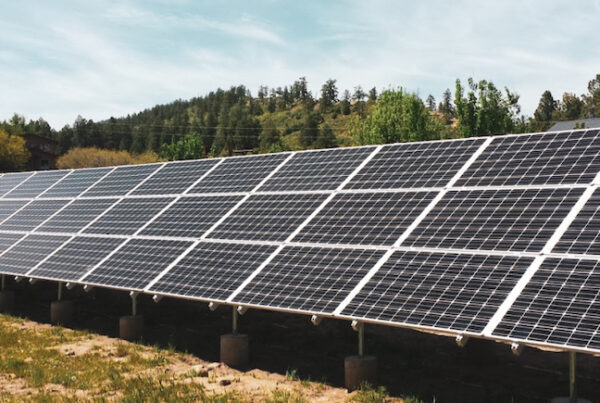The San Juan Basin is home to the highest concentration of methane pollution in the United States.
What is the methane hotspot?
The Four Corners has the unfortunate distinction of having some of the highest concentrations of methane pollution in the United States.
This anomaly is cause for serious concern – methane is the second most prevalent greenhouse gas behind carbon dioxide, and far more impactful. In the first 20 years after it’s emitted, methane is 86 times more potent than carbon dioxide. NASA and the University of Michigan released the report unveiling the hotspot in 2014, and in an August 2016 report they discovered that the natural gas extraction industry is responsible for a majority of the pollution. Methane leaks during every step of natural gas extraction, from production to distribution. Methane is also frequently wasted; when the gas is captured from oil drilling it is often simply vented off. Without strict rules regarding leak monitoring and detection, as well as waste prevention, methane emissions will only continue to worsen the hot spot here in the Four Corners.
Federal rules were created in 2016 to regulate methane pollution from the oil and gas industry. Under the Trump Administration, those rules were rolled back. Now states are leading the charge to minimize methane pollution and waste.

Methane (CH4) is a colorless, non-toxic, and highly flammable greenhouse gas. When burned, it turns into carbon dioxide. Methane is emitted by natural sources such as wetlands, and through human activities, primarily oil and gas drilling, coal mining and the raising of livestock. Methane is the primary component of natural gas, a fuel used for electricity generation that also contains other gases and volatile organic compounds (VOCs). The methane hotspot negatively impacts our communities here in the Southwest for some of the reasons listed below:
Climate Change
Methane, a powerful greenhouse gas, is far worse than carbon dioxide for the climate. Over 20 years methane is 86 times more potent than carbon dioxide. In 2013, New Mexico wasted more than 250,000 metric tons of methane – double the greenhouse gas emissions of the state’s 700,000 cars. In the Four Corners, a region particularly vulnerable to the effects of climate change, these emissions are cause for significant concern.
Waste
Methane waste is wasted money. Enough methane is leaked every year to fuel 10 million homes, and the lost gas is valued at an estimated $2 billion. Instead of wasting the gas, it could be recaptured and brought to market with existing technologies. In New Mexico alone, the state is losing up to $275 million in waste from oil and gas operations annually, which costs the state an additional $40 million in annual tax and royalty revenue.
Public Health
Methane alone is not a direct public health issue, but it is commonly associated with the concurrent release of volatile organic compounds (VOCs) and other toxic pollutants. These pollutants are linked to cancer, respiratory diseases and neurological damage.
Methane and VOCs also contribute to ground level ozone pollution, which harms human health in addition to worsening climate change. In 2018, the ozone in Colorado was so bad that the state issued warnings against outdoor exercise an average of more than once a week.
What causes the hotspot?
Natural Gas
Methane is the primary component of natural gas. It is emitted into the atmosphere during the production, processing, storage, transmission, and distribution of natural gas for energy. Many wells, especially legacy wells, are not properly cased or cemented to prevent leaks and many others are designed to vent or flare excess methane into the atmosphere.
In 2017, Hilcorp bought the Conoco-Phillips’ San Juan Basin oil and gas facilities. These facilities, particularly the coal-bed methane wells from the Fruitland coal formation, collectively add up to be the largest single source of methane in the United States.
Oil
Natural gas is often found alongside oil. Therefore, production, refinement, transportation, and storage of crude oil are also sources of methane emissions. In some circumstances, wells are designed to capture both oil and gas for market, but often natural gas is vented or flared and only oil is captured.
The San Juan Basin is home to 26,000 active oil and gas wells, and over 11,200 abandoned wells. As oil and gas production expands in the Permian basin, new studies suggest that methane emissions in New Mexico might be five times higher than previously thought.
See our Oil and Gas program page for more info.
Coal
Methane is also found in underground coal beds. Where a coal reserve meets the surface of the land, through natural seeps or mining, methane is released into the atmosphere. Sometimes this gas is captured, but often it is not.
The San Juan Basin is home to three coal mines – Navajo Mine, San Juan Mine, and King Coal Mine. The basin also contains methane seeps, the most prolific of which is the Fruitland outcrop.
See our Coal program page for more info.
Leakage of methane from natural gases processing facilities, like this one, are significant contributors to our methane problem.
When natural gas leaks from wells designed only for oil extraction, flaring (burning the waste gas) is a method for dealing with the excess methane.
Current Studies
Several agencies, including NASA and NOAA, are currently investigating the sources of methane. In August 2016, scientists from NASA Jet Propulsion Laboratory released a report confirming that the energy industry (mainly the natural gas industry) is responsible for a majority of the methane pollution in the San Juan Basin. Additional studies from NASA and NOAA are underway and will further identify sources of methane in the area.
“Most of the [methane] plumes we observed were directly related to industrial facilities.” – Christian Frankenberg, NASA


States Take the Lead
The Environmental Protection Agency (EPA) and the Bureau of Land Management (BLM) both implemented methane rules in 2016 to limit methane waste during production. Unfortunately, the EPA gutted their rule, despite industry support for strong protections and the BLM is similarly working to roll theirs back. For now, we’ll have to rely on state regulations to control methane emissions. Both Colorado and New Mexico are moving forward to implement new methane rules and regulations:
Colorado

In 2014 Colorado became the first state to regulate methane emissions from oil and gas sites, thus setting the bar for the nation. The rules direct companies to find and fix methane leaks, and also require them to install equipment to capture emissions.
New State Legislation
Even with the 2014 regulations, Colorado’s methane emissions still cause ozone problems and unhealthy air. Frenzied growth in the oil and gas industry, flawed reporting, and unmonitored emissions have all led to a need for more stringent rules.
Recognizing this need, major legislation was passed during the 2019 State Legislative session to cut and monitor methane emissions:
- SB 19-096: This bill directs the Air Quality Control Commission (AQCC) to collect greenhouse gas emissions data from greenhouse-gas emitting entities. The reports and forecast of future emissions from this bill will inform new rules to address emissions
- SB 19-181: 181 protects public welfare by regulating the oil and gas industry. Specifically, it directs the AQCC to adopt new rules to minimize the emissions of methane and other hydrocarbons and VOCs
- HB 19-1261: This house bill sets new greenhouse gas emissions goals, and directs that 2050 emissions must be 90% below 2005 levels. It directs the AQCC to implement policies and rules to attain these goals
What next?
After 2019’s Legislative Session, committees are reorganizing to form the new emissions rules, regulations, and standards. Public hearings and comment periods are expected to take place statewide, so stay involved and make sure your voice is heard!
New Mexico

A 2018 study found that New Mexico has the worst local regulations for methane emissions in the entire country. The state is losing up to $275 million in waste from oil and gas operations annually, which costs the state an additional $40 million in annual tax and royalty revenue.
Forward-thinking Executive Orders
As oil and gas operations in New Mexico continue to surge, the state needs new methane regulations to control the pollutant.
In January 2019, New Mexico Governor Michelle Lujan Grisham signed an executive order to clean up the state’s energy, reduce pollution, and protect against the impacts of climate change.
The executive order directs that:
- New Mexico will support the 2015 Paris Climate Agreement, meaning they will reduce greenhouse gas emissions by 45% from 2005 levels by 2030.
- A Climate Task Force is to be created, which will create a statewide climate strategy for all state agencies and programs.
- The Energy, Minerals and Natural Resources Department (EMNRD) and the Environment Department (NMED) will develop new regulations to reduce methane emissions and waste from the oil and gas sector.
What next?
EMNRD and NMED are beginning stakeholder processes on the new methane strategy beginning in July 2019. They will hold meetings throughout the state and take public comment to inform the new regulatory process.
Recent News





